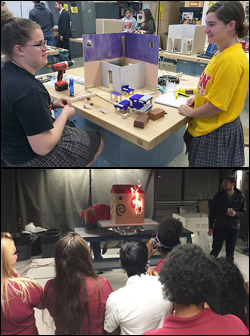News Story
FPE Design Challenge Gets High School Students Excited About Engineering

Above: ESHS students building their model home. Below: One of the model homes is subjected to a burn test in FPE's Rolf Jensen and Associates Fire Science Laboratory.
Students from Elizabeth Seton High School (ESHS) were the first to earn the title of “junior fire protection engineers” after participating in a new program at the University of Maryland. The program, called the FPE Design Challenge, was created and presented by students from the Department of Fire Protection Engineering (FPE).
In addition to providing an introduction to FPE, the program also introduced participants to creative design and construction, and required them to formulate and test hypotheses using the scientific method. The program’s goals were to encourage the students to consider careers in science, technology, engineering and math (STEM), and to help them gain confidence in their ability to succeed in those fields.
The FPE Design Challenge was conceptualized by FPE professor and chair Jim Milke and FPE assistant director Nicole Hollywood, who thought a competition inspired by the one held in the Clark School’s Introduction to Engineering Design course would be a good way to get high school students, particularly young women and members of underrepresented minorities, engaged and interested in engineering. After refining their ideas with the help of department undergraduates Cara Hamel (B.S. ’15) and Raquel Hakes, Milke and Hollywood recruited Ph.D. student Taylor Myers (B.S.’12, M.S. ’14) to develop the curriculum and lead the program.
Myers, Hamel and Hakes enlisted three additional FPE undergraduates –Sara Caton (B.S. ’15), Nate May, and Jon Scheer (B.S. ’15) – to help create lessons covering core fire protection strategies such as compartmentalization, ventilation, material flammability, detection, and suppression, which could be incorporated into projects in the FPE Design Challenge.
Hollywood and Myers pitched the completed curriculum to the all-girls Elizabeth Seton High School, after Hamel, an ESHS alumna, connected them with its principal and president, Sister Ellen Marie Hagar. The school agreed to make the FPE Design Challenge part of its STEM program. Myers and his team provided the instruction, most of which took place on the ESHS campus.
The program’s final competition focused on the design of a home fire protection system. After covering the core concepts, the students were asked to apply what they had learned to design and build a scale model home capable of resisting fire spread. At the conclusion of the program, the students brought their models to FPE’s Rolf Jensen and Associates Fire Science Laboratory in College Park, where they were put to the test in live burn experiments.
"The [FPE] student mentors were a great help in helping my group think through the challenges we faced, and deciding on the best solution," says ESHE alumna Myranda Hinkson, who participated in the FPE Design Challenge and will be attending UMD in the fall. "My favorite part of the project was bringing our house to UMD to watch it burn…I found it really interesting to see how well, or not so well, all of the different designs from each group ended up working." The program, she adds, made her more aware of how science is used in real world contexts, and increased her interest in FPE.
“The students were very excited by the project, dedicated a large amount of personal time to it, and showed tremendous creativity,” says Myers.
One team, for example, used popcorn as part of their alarm system. Another built their home and everything in it (including the furniture) out of cement board. While this level of Brutalist design would be a hard sell in the 21st century real estate market, Myers admits that when it came to fire protection, it worked well.
“Our best metric for fire damage was the percentage of mass loss, which tells you how much of the structure was burned,” he says. “Our Brutalist house suffered 0% mass loss, with no noticeable change. In contrast, the worst performing house lost 18% of its mass, and was completely destroyed.”
He describes the feedback he’s received as almost entirely positive, and is already preparing for a Spring 2016 cohort. “We’d like to bring the program back, with slightly different requirements and improved lessons, to Elizabeth Seton and possibly another school,” he says.
Milke, meanwhile, is working with Scheer, now a student in FPE’s Master of Engineering program, on translating the FPE Design Challenge into a 100-level undergraduate engineering course.
Published July 7, 2015









